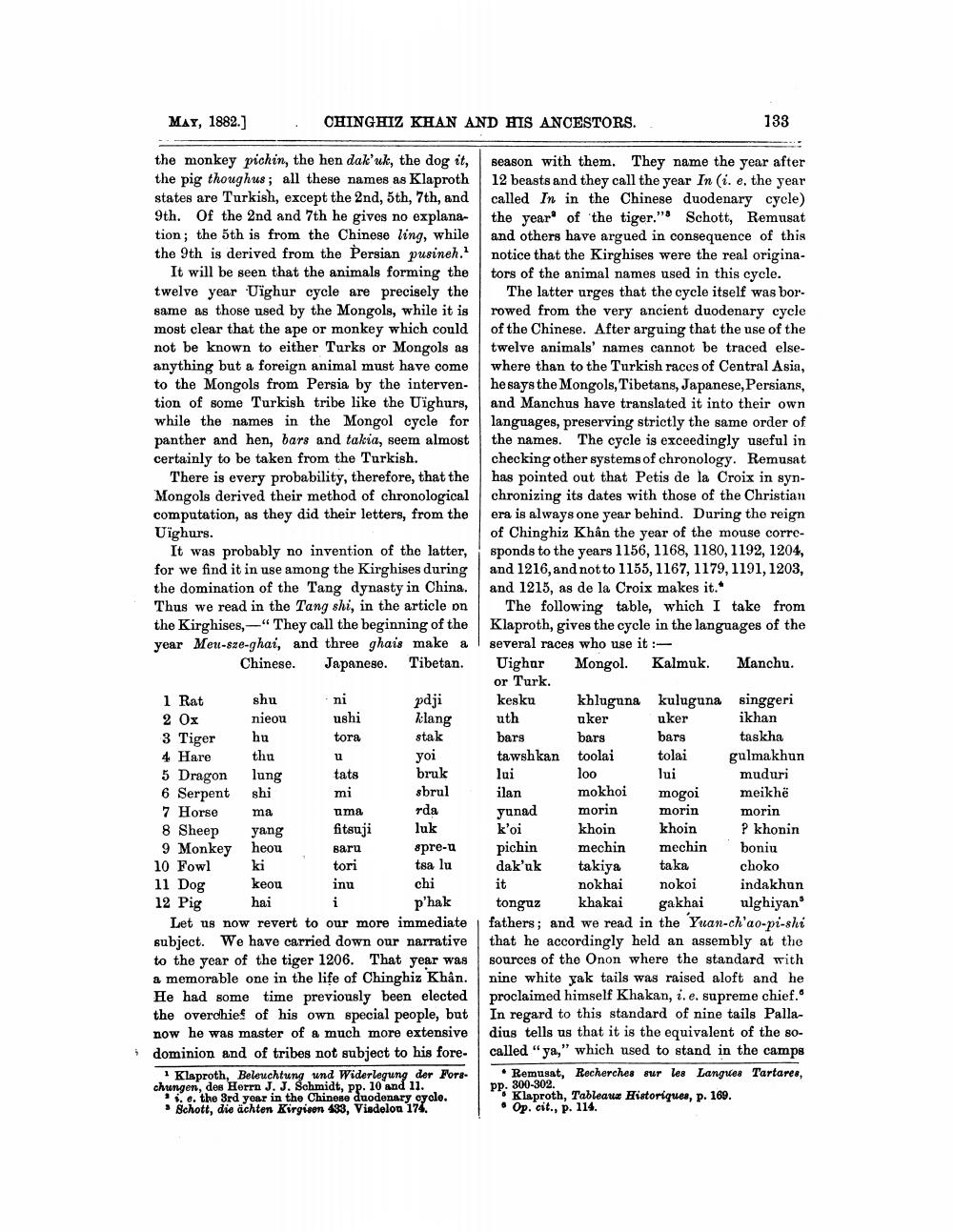________________
MAY, 1882.)
CHINGHIZ KHAN AND HIS ANCESTORS.
133
the monkey pichin, the hen dak'uk, the dog it, the pig thoughus; all these names as Klaproth states are Turkish, except the 2nd, 5th, 7th, and 9th. Of the 2nd and 7th he gives no explanation; the 5th is from the Chinese ling, while the 9th is derived from the Persian pusineh.'
It will be seen that the animals forming the twelve year Uighur cycle are precisely the same as those used by the Mongols, while it is most clear that the ape or monkey which could not be known to either Turks or Mongols as anything but a foreign animal must have come to the Mongols from Persia by the intervention of some Turkish tribe like the Uighurs, while the names in the Mongol cycle for panther and hen, bars and takia, seem almost certainly to be taken from the Turkish.
There is every probability, therefore, that the Mongols derived their method of chronological computation, as they did their letters, from the Uighurs.
It was probably no invention of the latter, for we find it in use among the Kirghises during the domination of the Tang dynasty in China. Thus we read in the Tang shi, in the article on the Kirghises,—“They call the beginning of the year Meu-sao-ghai, and three ghais make a
Chinese. Japanese. Tibetan.
|
season with them. They name the year after 12 beasts and they call the year In (i. e, the year called In in the Chinese duodenary cycle) the year of the tiger." Schott, Remusat and others have argued in consequence of this notice that the Kirghises were the real originators of the animal names used in this cycle.
The latter urges that the cycle itself was borrowed from the very ancient duodenary cycle of the Chinese. After arguing that the use of the twelve animals' names cannot be traced elsewhere than to the Turkish races of Central Asia, he says the Mongols, Tibetans, Japanese, Persians, and Manchus have translated it into their own languages, preserving strictly the same order of the names. The cycle is exceedingly useful in checking other systems of chronology. Remusat has pointed out that Petis de la Croix in synchronizing its dates with those of the Christian era is always one year behind. During the reign of Chinghiz Khân the year of the mouse corresponds to the years 1156, 1168, 1180, 1192, 1204, and 1216, and not to 1155, 1167, 1179, 1191, 1203, and 1215, as de la Croix makes it.*
The following table, which I take from Klaproth, gives the cycle in the languages of the several races who use it :Uighur Mongol. Kalmuk. Manchu. or Turk. kesku k hluguna kuluguna singgeri uth
aker uker ikhan bars bars bars taskha tawsh kan toolai tolai gulmakhun lui loo lui
muduri ilan mokhoi mogoi
meikhë yunad
morin morin morin k'oi khoin khoin ? khonin pichin mechin
mechin boniu dak'ak takiya taka c hoko it
nokhai nokoi indakhun tonguz khakai gakhai ulghiyan fathers; and we read in the Yuan-ch'ao-pi-shi that he accordingly held an assembly at the sources of the Onon where the standard with nine white yak tails was raised aloft and he proclaimed himself Khakan, i.e. supreme chief. In regard to this standard of nine tails Palladius tells us that it is the equivalent of the 80called "ya," which used to stand in the camps
Remusat, Recherches sur les Langues Tartares, pp. 300-302. ** Klaproth, Tableaux Historiques, p. 169.
• Op. cit., p. 114.
1 Rat shu ni
pdji 2 Ox nieou ushi
klang 3 Tiger hu
tora
stak 4 Hare thu
yoi 5 Dragon lung tats
bruk 6 Serpent shi mi
sbrul 7 Horse ma
ima rda 8 Sheep yang
fitsuji
luk 9 Monkey heou Baru
spre10 Fowl
tori tsa lu 11 Dog keou inu chi 12 Pig hai i
p 'hak Let us now revert to our more immediate subject. We have carried down our narrative to the year of the tiger 1206. That year was a memorable one in the life of Chinghiz Khân. He had some time previously been elected the overchief of his own special people, but now he was master of a much more extensive dominion and of tribes not subject to his fore
1 Klaproth, Beleuchtung und Widerlegung der Forschungen, des Herrn J. J. Schmidt, pp. 10 and 11.
8.e. the 3rd year in the Chinese duodenary oyolo. Schott, die ächten Kirgisen 433, Viedelon 174.




